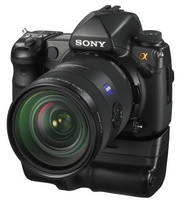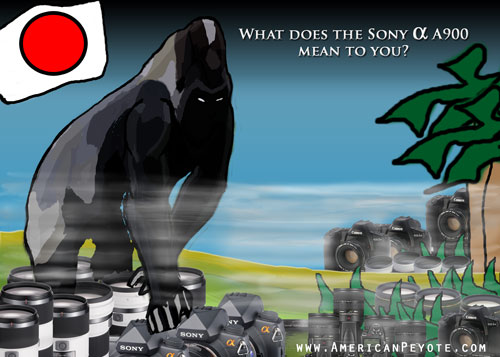The end is near, and hack camera writers across the web are digging in for the mad-capped pseudo blood-bath set to be unleashed on the digital camera world. The release of the Sony A900, the full-framed 24 Megapixel beast will be launched before the end of 2008. There’s little doubt that Sony will unveil a DSLR marketing spectacle like the world has never seen at Photokina 2008 in Cologne (September 23rd-28th), and it might even be worth attending this year.
For give-or-take a decade now the DSLR market has been dominated by small sensor APS-sensor sized offerings, and Full Frame 35mm sized image sensors have been integrated into only a few cameras models, such as in the release of high-end Canon cameras such as the EOS-1Ds and more affordable 5D models, plus a few washout releases by Kodak. Full-frame 35mm image sensors have many advantages, in particular that the majority of DSLR lenses are designed for that sensor size. All the benefits of selective focus and shallow depth of field can be fully exploited when paired with 35mm sensors, which are less pronounced when one uses a 35mm-designed lens on an APS-sized camera body. So far the benefits of larger imaging sensors have stayed in the plus of $2500-$3000 (at the low end). Even the recent release of the affordable ($3000 MSRP) 35mm full-frame camera by Nikon; the D700 is really only there for professionals and gear heads thirsty to drop money on a new trophy camera. The D700 competes directly with the Canon 5D, which originally brought full-frame capabilities to pros and advanced amateurs the world over for the lowly MSRP price of $3299. The release of the Canon 5D and Nikon D700 were significant, but for true innovation the market need competition.
Competition benefits the consumer, and Canon has been the Microsoft of the digital camera market, nearly fully dominating the 35mm full-frame digital segment since it started. There’s good reason for it; Canon does cameras, lenses, sensors, and software/firmware, all of which are key components needed to produce a successful digital camera. Canon has the means of developing all of these essential components in-house using one design strategy.
By comparison, every other DSLR company has been able to do maybe two of the above (at most), but without the last piece of the development puzzle it’s been difficult to match Canon, which generally means the ability to develop and manufacture the imaging sensor. Many companies, such as Nikon have relied on partner companies to design and manufacture the imaging sensors. So while Nikon, Pentax, Minolta, Leica and Olympus could design great cameras and lenses, they couldn’t build DSLRs without sensors from companies like Sony. Sony produces many of the imaging sensors used in current point-and-shoot as wells as DSLR cameras. But it wasn’t until Sony bought the camera technology from Minolta that they could start developing the Alpha DSLR System. The true strength of Canon has been its ability to develop, manufacture, and release DSLR models faster and with more precision than the competition. Even Nikon hasn’t kept up with the Canon camera release cycle and only released its first full-frame model a year ago in the form of the D3. Nikon is improving in this respect, but there is now another beast in the DSLR Jungle.
Enter an 800 Pound Gorilla…
Unlike every other camera company, Sony can actually match and beat Canon in the camera development game. Sony bought the camera and lens technology from Minolta, who got out of the camera business because it couldn’t develop and release cameras at the rate of competitors. Sony has partnered with Carl Zeiss, who now designs and oversees production of high-end lenses and markets the Zeiss ZA line for the Sony Alpha mount. And as a final piece in the puzzle, Sony can design and produce their own imaging sensors, which is something only Canon does at the moment (although Nikon has recently started down this road with the D3 and D700). Add to that the fact that Sony is huge, with distribution centers and marketing people in every corner of the globe, and it’s a sure bet that with an aggressive business strategy they’ll change the DSLR playing field. Why? Because Sony doesn’t enter markets just to release products, they’re a contender. Sony over turned the high-end video and camcorder markets, and they’re poised to do the same with DSLRs – with the new A900.
 The soon to be released A900 from Sony could change the status quo of the DSLR world. The release of the A900 will mean that together with Canon and Nikon, there will be three major development and manufacturing entities producing and marketing DSLRs with full-framed 35mm image sensors to the general consumer market. The potential technology infusion and price reductions could be the first real signs of an end (or at a least plateau) to the DSLR evolution game. The 2007/08 DSLR offerings from Sony have been significant. The A700 was released in late 2007. Essentially the upgrade to the Minolta 7D, which fans of the camera had been waiting for, which showed the world that Sony can design and manufacture a serious DSLR. Sony has implemented excellent Live-View capabilities as well as vibration reduction technology into their camera bodies (like the Sony A350), at prices which make the Alpha system extremely attractive for camera buyers transitioning from point-and-shoot models to DSLRs.
The soon to be released A900 from Sony could change the status quo of the DSLR world. The release of the A900 will mean that together with Canon and Nikon, there will be three major development and manufacturing entities producing and marketing DSLRs with full-framed 35mm image sensors to the general consumer market. The potential technology infusion and price reductions could be the first real signs of an end (or at a least plateau) to the DSLR evolution game. The 2007/08 DSLR offerings from Sony have been significant. The A700 was released in late 2007. Essentially the upgrade to the Minolta 7D, which fans of the camera had been waiting for, which showed the world that Sony can design and manufacture a serious DSLR. Sony has implemented excellent Live-View capabilities as well as vibration reduction technology into their camera bodies (like the Sony A350), at prices which make the Alpha system extremely attractive for camera buyers transitioning from point-and-shoot models to DSLRs.
Once one transitions from a Sony W300 point-and-shoot to an A200, A300, A350, or A700 DSLR; the energized customer will be thirsty for something…more. The A900 will be the ultimate fulfillment of that thirst (at least until the next model), and has the potential to establish Sony as a serious camera Brand – not a rebagged Minolta camera maker, not a me-too-jump-on-the-bandwagen DSLR distributer, but a full-time serious contender in the DSLR Jungle. The most important notion here is that a full-frame DSLR from Sony will have to have a price lower than that of Nikon and Canon to be competitive. The A900 will have Sony Super SteadyShot (SSS) built into the body as well as a 24.6 Megapixel CMOS imaging sensor. According to Mark Weir (Sony Digital Imaging and Audio Division), the senior technology and marketing manager of the Alpha camera line, the 24.6 Megapixel sensor will achieve very low noise due to an intelligent A/D converter technique (as reported at PMA 2008 in a Calumet Photo interveiw). This could be significant, since it is generally felt that sensor noise has to dramatically increase with high pixel density. If the A900 retains it’s high resolution with low noise levels and is offered at a price point below that of the competitors, the A900 could be an excellent options for photographers needing medium format resolution in a 35mm sized body. The next camera with such features is the Canon 1Ds-Mark III, which boasts 21 Megapixels and retails for nearly $8,000.
The true profits for digital camera makers is not in the cameras but in the system. Sony lenses, memory cards, flashes, and other random add-ons is where the long-term profit strategy exists. The point is to get people into the Alpha System, because once you have a sweet 24 megapixel beast in your hand, you want to fully exploit its potential with a Carl Zeiss 24-70 f/2.8, Sony 80-200 f/2.8, or any of the variety of other lenses which are currently available – as well as those that will be released into the marketplace. Not to mention a vertical grip to make the camera look cool, as well as the flagship Sony FL-58 flash, which actually has one of the most innovative head designs of any other maker, and boasts excellent wireless control for additional flashes.
I’m looking forward to the Sony A900, and might actually buy one. The successful Canon 5D is now essentailly discontinued and can be had for less than $2000, but only until the successor is released (probably called the Canon 6D). Aside from the new Canon 5D replacement and the new offerings from Nikon (the just released D700 and soon to be here D3x), the Sony A900 should have the biggest impact on the DSLR market in 2009. It will affect camera prices, encourage (more like force) innovation, and no matter your favorite brand, the release of the A900 will have a positive impact on the DSLR Jungle.
